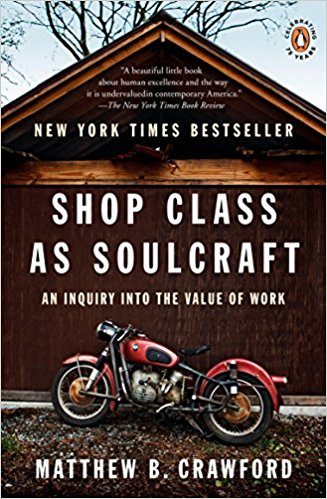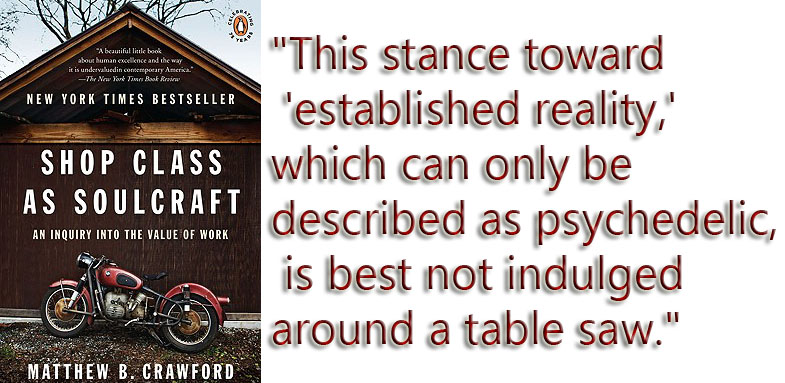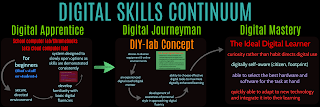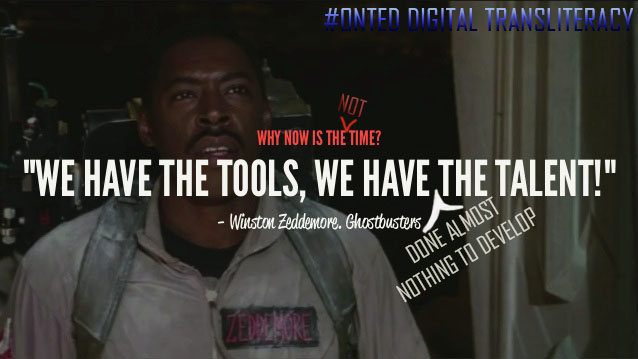
I’m currently reading the very meaty and painfully direct “Shop Class as Soulcraft” by Matt Crawford. In the book he laments idiocy in professionals and (at another point) the vagaries of management language in modern business where there is no objective means of determining an employee’s competency. Both of these arguments come together beautifully in the relatively recent field of information technology.
I’ve been working in IT, both in the private and public sectors, for going on fifteen years now. I’ve worked in small offices, and on massive installs, in engineering shops, manufacturing concerns, universities, schools, and in offices. With a certain breadth of experience comes a pretty good bullshit detector. Crawford’s ideas around professional idiocy and manager-speak appear to have, unfortunately, come together in a perfect storm of hidden incompetence in information technology.
THE IDIOT
Crawford talks about Robert Persig (the author of Zen and the art of motorcycle maintenance – another great read)’s idiot mechanic, who is more intent on appearances and action than submitting himself to the truths the bike is trying to tell him, and what that means to his public role as a professional mechanic. The kid ends up butchering Persig’s bike while taking no time to actually try and diagnose what the problem is; he’s all hands and no brain. Crawford describes the idiot:
“Persig’s mechanic is, in the original sense of the word, an idiot. Indeed, he exemplifies the truth about idiocy, which is that it is at once an ethical and a cognitive failure. The Greek idios means “private,” and an idiotes means a private person, as opposed to a person in their public role – for example, that of motorcycle mechanic. Persig’s mechanic is idiotic because he fails to grasp his public role, which entails, or should, a relation of active concern to others, and to the machine. He is not involved. It is not his problem. Because he is an idiot… At bottom, the idiot is a solipsist.” (p98)
That lack of involvement should spark a memory with any teacher reading this. The student who refuses, at all costs, regardless of the differentiation you throw at it, to do anything whatsoever, is an idiot in the technical sense of the word.
From the IT angle, I see people like Persig’s idiot mechanic every day. You know the type, they know just enough to be dangerous (and have tools on hand). They tend to make grand assumptions, usually based on a non-existent knowledge base, and then act on them to make the situation worse. They talk loudly, and use a lot of word whispers (“you know?”, “right?”, “know what I mean?”, etc) to make sure you agree with them (it’s a handy way to externally monitor what’s going on when you have no idea yourself, and dovetails nicely with the idea of management speak presented later).
The disengaged idiot fits especially well with information technology because it’s a dark art to the vast majority of people. You can talk out of your ass to 95% of the population and they have no idea what you’re saying, freeing you to say pretty much anything you want. The bigger the words the better. And because most people are users, they’re more than happy to sit in on the tech talk, and participate at the same level as the disengaged idiot.
Many moons ago, right out of high school, I found myself working in a Canadian Tire shop. One day one of the mechanics burned himself on Fuego. He proceeded to flip out and run up a bill of unneeded repairs to the order of a thousand dollars; a good example of the moral failure of the idiot, and one I see all the time in IT, especially when dealing with older customers to whom the dark art seems positively Satanic.
MANAGEMENT SPEAK
Crawford also does a brilliant dissection of the ‘peculiarly chancy and fluid’ life of the corporate manager (substitute administrator or educational consultant for equal value here). In a world with no objective means of assessing competence, the manager lives in a purgatory of abstraction, using vague language “…staking out a position on all sides of a situation, so you always have plausible deniability of a failure.” Crawford goes to great lengths to point out that this isn’t done maliciously, but rather as a means of psychic protection for the people trapped in this morass. At any point an arbitrary decision can make you redundant (shown brilliantly in Up In The Air – many of the people in the interviews are real people who have actually been downsized), regardless of your own abilities or actions.
 In a world of meaningless language, actual technical competency is devalued with every spoken word (a central theme in Crawford’s book). Objective competency is ignored in favor of MBA wording that allows the initiate of globalized business speak to survive regardless of what decisions they might have made. In fact, the very making of decisions is discouraged. In places where reality matters, your opinion is not as important as it has been socially projected to be. As Crawford so cuttingly notes: “This stance toward ‘established reality,’ which can only be described as psychedelic, is best not indulged around a table saw.”
In a world of meaningless language, actual technical competency is devalued with every spoken word (a central theme in Crawford’s book). Objective competency is ignored in favor of MBA wording that allows the initiate of globalized business speak to survive regardless of what decisions they might have made. In fact, the very making of decisions is discouraged. In places where reality matters, your opinion is not as important as it has been socially projected to be. As Crawford so cuttingly notes: “This stance toward ‘established reality,’ which can only be described as psychedelic, is best not indulged around a table saw.”
One of the many reasons I’m looking forward to ‘teaching tech’ this fall; there is no doubt of the student’s focus, ability and honesty of effort when reality is judging them. If you made it, ignored lessons, examples and process, and it didn’t work, no amount of ‘but you’re still fantastic’ student success talk will mitigate a failure staring everyone in the face. The fantasy of ‘everyone’s a hidden genius’ so popular in education today is best not indulged when reality (and the objective assessment implied in it) are judging the results. Do or do not, there is no good try in tech… and that’s not a bad thing, unless you’re trying to peddle a new ed-theory on zero failure.
Management speak, based on the the surreal, ‘psychedelic’, entirely provisional world of business became popular along with globalization (itself founded on many hidden assumptions). Grown out of the initial industrially driven abstractions of Taylorism in the early 20th Century, modern business is so far from the witness of truth (like the stock market it has spawned) that it has more in common with Alice in Wonderland than it does with a shop manual; the best you can hope for are some vague metaphors to describe it.
The IT Idiot Management Babbling: Making An Objective Technical Skill Abstract
Information technology is a new technical field. It began and grew in a well established, Taylorist, globalized, MBA driven, entirely fictional world. The language around IT maintenance is often clouded in mysticism, grown from the same vague, plausibly deniable language of modern business and finance. We feed that fire with talk of digital natives, people who magically have technical skills because of their birth date. In education, we ignore this new, vital fluency in favor of magical realism; our adherence to business speak serves our students poorly.
I’m not saying every student needs to be a qualified information technology technician, but it is safe to say that every student graduating at the moment should be familiar enough with digital technology that they don’t get white washed by an idiot’s babbling, or convinced by the parochial and intentionally misleading language surrounding information technology. Auto shop is often taught this way – as a means of delivering a basic familiarity to students so they aren’t bamboozled by an idiot. IT should adopt the same position as this older, wiser tech.
IT is a measurable skill. I take great pleasure in offering up the A+ certification practice test to the resident experts in senior computer engineering. When the best of them barely get half right, and realize that they are 30% away from a pass, it sets the stage for a systemic, meaningful learning of a technical skill they’ve always been told they magically gained by being born in the nineties.
I wonder if people born in the 1900s were magically imbued with the ability to fix the new automobiles just coming out. What we do is absurd, and it feeds misinformation and empowers the idiot. It’s bad enough when we purposefully remove objective standards from academic classes (and I’m not talking about standardized tests – they are about as far from objective standards as you can get, just another fiction), but to actively discourage objective standards in a technical field? That gets downright dangerous, and expensive!



























































